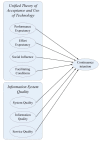The Determinants for Food Safety Push Notifications on Continuance Intention in an E-Appointment System for Public Health Medical Services: The Perspectives of UTAUT and Information System Quality
- PMID: 33182479
- PMCID: PMC7665118
- DOI: 10.3390/ijerph17218287
The Determinants for Food Safety Push Notifications on Continuance Intention in an E-Appointment System for Public Health Medical Services: The Perspectives of UTAUT and Information System Quality
Abstract
Compared to other appointment methods in public hospitals, registering through the Internet or utilizing e-appointments, or registering online as an outpatient, can provide more information to the user. This research investigated the integration of unified theory of the acceptance and use of technology and information system quality in determining factors that influence the adoption of e-appointments by patients, based on the requirements of food safety consultation in Taiwan. Empirical data from 369 valid samples were assessed using Partial Least Squares (PLS). The key findings of this study indicated that patients' acceptance of e-appointments was influenced by users' perceptions (i.e., performance expectancy and facilitating conditions), along with information quality and service quality. The practical and academic implications are provided for future practitioners and scholars, and to enhance patients' usage of e-appointments in their healthcare activities.
Keywords: e-appointment; information system quality (ISQ); partial least squares (PLS); public medical services; push notifications of food safety; unified theory of the acceptance and use of technology (UTAUT).
Conflict of interest statement
The authors declare no conflict of interest.
Similar articles
-
Patients' intention to use online postings of ED wait times: A modified UTAUT model.Int J Med Inform. 2018 Apr;112:34-39. doi: 10.1016/j.ijmedinf.2018.01.008. Epub 2018 Jan 12. Int J Med Inform. 2018. PMID: 29500019
-
Understanding consumer acceptance of healthcare wearable devices: An integrated model of UTAUT and TTF.Int J Med Inform. 2020 Jul;139:104156. doi: 10.1016/j.ijmedinf.2020.104156. Epub 2020 Apr 24. Int J Med Inform. 2020. PMID: 32387819
-
Understanding factors influencing the adoption of mHealth by the elderly: An extension of the UTAUT model.Int J Med Inform. 2017 May;101:75-84. doi: 10.1016/j.ijmedinf.2017.02.002. Epub 2017 Feb 10. Int J Med Inform. 2017. PMID: 28347450
-
Research on elderly users' intentions to accept wearable devices based on the improved UTAUT model.Front Public Health. 2023 Jan 9;10:1035398. doi: 10.3389/fpubh.2022.1035398. eCollection 2022. Front Public Health. 2023. PMID: 36699866 Free PMC article.
-
A meta-analysis based modified unified theory of acceptance and use of technology (meta-UTAUT): a review of emerging literature.Curr Opin Psychol. 2020 Dec;36:13-18. doi: 10.1016/j.copsyc.2020.03.008. Epub 2020 Apr 3. Curr Opin Psychol. 2020. PMID: 32339928 Review.
Cited by
-
Café Food Safety and Its Impacts on Intention to Reuse and Switch Cafés during the COVID-19 Pandemic: The Case of Starbucks.Int J Environ Res Public Health. 2023 Feb 1;20(3):2625. doi: 10.3390/ijerph20032625. Int J Environ Res Public Health. 2023. PMID: 36767990 Free PMC article.
-
Paving the way for increased e-health record use: elaborating intentions of Gen-Z.Health Syst (Basingstoke). 2022 Oct 3;12(3):281-298. doi: 10.1080/20476965.2022.2129471. eCollection 2023. Health Syst (Basingstoke). 2022. PMID: 37860594 Free PMC article.
-
Acceptance of artificial intelligence clinical assistant decision support system to prevent and control venous thromboembolism among healthcare workers: an extend Unified Theory of Acceptance and Use of Technology Model.Front Med (Lausanne). 2025 Feb 11;12:1475577. doi: 10.3389/fmed.2025.1475577. eCollection 2025. Front Med (Lausanne). 2025. PMID: 40007590 Free PMC article.
-
The use of various appointment systems among patients visiting academic outpatient centers in Kerman and the evaluation of patients' perspective and satisfaction.BMC Health Serv Res. 2022 Nov 14;22(1):1344. doi: 10.1186/s12913-022-08635-6. BMC Health Serv Res. 2022. PMID: 36376969 Free PMC article.
-
Barriers and Facilitators to Automated Self-Scheduling: Consensus from a Delphi Panel of Key Stakeholders.Perspect Health Inf Manag. 2022 Jan 1;19(1):1m. eCollection 2022 Winter. Perspect Health Inf Manag. 2022. PMID: 35440921 Free PMC article.
References
-
- Chen S.C., Chen H.H., Chen M.F. Determinants of satisfaction and continuance intention towards self-service technologies. Ind. Manag. Data Syst. 2009;109:1248–1263. doi: 10.1108/02635570911002306. - DOI
-
- Lin J.S.C., Hsieh P.L. Assessing the self-service technology encounters: Development and validation of SSTQUAL scale. J. Retail. 2011;87:194–206. doi: 10.1016/j.jretai.2011.02.006. - DOI
-
- Horvath M.M., Rusincovitch S.A., Brinson S., Shang H.C., Evans S., Ferranti J.M. Modular design, application architecture, and usage of a self-service model for enterprise data delivery: The Duke Enterprise Data Unified Content Explorer (DEDUCE) J. Biomed. Inform. 2014;52:231–242. doi: 10.1016/j.jbi.2014.07.006. - DOI - PMC - PubMed
-
- Kitsios F., Stefanakakis S., Kamariotou M., Dermentzoglou L. E-service Evaluation: User satisfaction measurement and implications in health sector. Comput. Stand. Interfaces. 2019;63:16–26. doi: 10.1016/j.csi.2018.11.002. - DOI
MeSH terms
LinkOut - more resources
Full Text Sources


